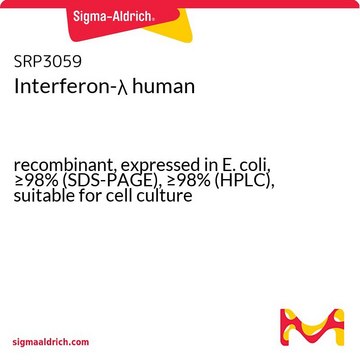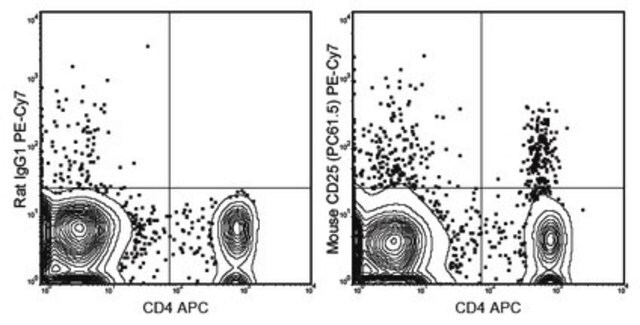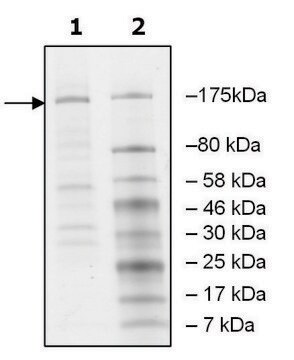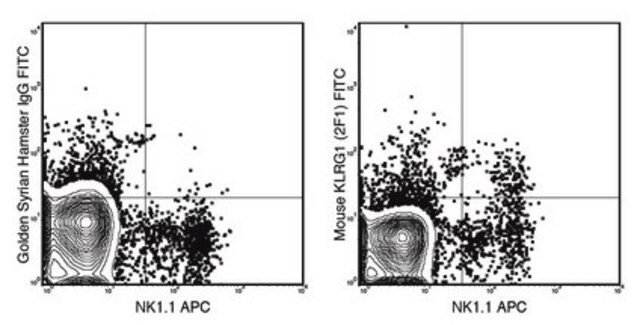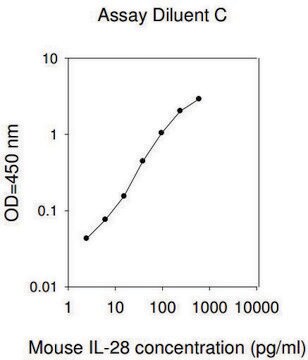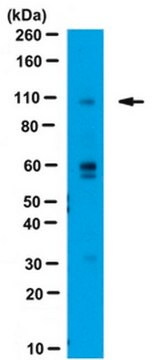MABF227
Anti-Interferon Lambda 4, clone 4G1 Antibody
clone 4G1, 1 mg/mL, from mouse
Synonim(y):
Interferon lambda-4, IFN-lambda-4
About This Item
Polecane produkty
pochodzenie biologiczne
mouse
Poziom jakości
forma przeciwciała
purified immunoglobulin
rodzaj przeciwciała
primary antibodies
klon
4G1, monoclonal
reaktywność gatunkowa
nonhuman primates, human
spodziewany brak reakcji z
porcine, giant panda, canine, bat, bovine
stężenie
1 mg/mL
metody
ELISA: suitable
flow cytometry: suitable
immunocytochemistry: suitable
immunohistochemistry: suitable
western blot: suitable
izotyp
IgG1κ
numer dostępu NCBI
numer dostępu UniProt
Warunki transportu
wet ice
docelowa modyfikacja potranslacyjna
unmodified
informacje o genach
bat ... Loc102244039(102244039)
human ... IFNL4(101180976)
Opis ogólny
Specyficzność
Immunogen
Zastosowanie
ELISA Analysis: A representative lot was conjugated with a sulfo-tag (MSD) and employed as the detection antibody in a sandwich ELISA application. An exogenously expressed IFNL4 HaloTag fusion was found secreted in the culture media from IFNL4-Halo construct-transfected, but not mock-transfected HepG2 cells (Onabajo, O.O., et al. (2015). J. Interferon. Cytokine Res. 35(11):888-900).
Flow Cytometry Analysis: A representative lot immunostained HepG2 cells transfected to express HaloTag fusion IFN-λ4 orthologs of elephant, human and non-human primate (chimpanzee, orangutan, rhesus, marmoset, cynomolgus) origins, but not cells expressing IFNL4 of bovine, bat, canine, panda, and porcine species (Paquin, A., et al. (2016). J. Interferon Cytokine Res. 36(1):30-36).
Immunocytochemistry Analysis: Representative lots immunostained HepG2 cells transfected to express HaloTag fusion of IFN-λ4 orthologs of elephant, human and non-human primate (chimpanzee, orangutan, rhesus, marmoset, cynomolgus) origins (Paquin, A., et al. (2016). J. Interferon Cytokine Res. 36(1):30-36; Prokunina-Olsson, L., et al. (2013). Nat. Genet. 45(2):164-171).
Immunocytochemistry Analysis: A representative lot detected a time-dependent induction of IFNL4 expression in hepatocytes from a donor heterozygous for ss469415590 (TT/ΔG) upon PolyI:C treatment or hepatitis C virus (HCV) strain JFH1HCV infection in cultures (Prokunina-Olsson, L., et al. (2013). Nat. Genet. 45(2):164-171).
Western Blotting Analysis: A representative lot detected HaloTag fusion IFN-λ4 orthologs of elephant, human and non-human primate (chimpanzee, orangutan, rhesus, marmoset, cynomolgus) origins, but not IFNL4 of bovine, bat, canine, panda, and porcine species transiently expressed in HepG2 cells (Paquin, A., et al. (2016). J. Interferon Cytokine Res. 36(1):30-36).
Western Blotting Analysis: A representative lot detected exogenously expressed IFNL4 HaloTag fusion constructs in transfected COS-7 and HepG2 cells, but not in untransfected cells. Clone 4G1 does not cross-react with IFN-alpha or IL-28B (Prokunina-Olsson, L., et al. (2013). Nat. Genet. 45(2):164-171).
Jakość
Western Blotting Analysis: 1.0 µg/mL of this antibody detected 0.1 µg of human IFNL4 recombinant protein.
Opis wartości docelowych
Postać fizyczna
Nie możesz znaleźć właściwego produktu?
Wypróbuj nasz Narzędzie selektora produktów.
Kod klasy składowania
12 - Non Combustible Liquids
Klasa zagrożenia wodnego (WGK)
WGK 1
Temperatura zapłonu (°F)
Not applicable
Temperatura zapłonu (°C)
Not applicable
Certyfikaty analizy (CoA)
Poszukaj Certyfikaty analizy (CoA), wpisując numer partii/serii produktów. Numery serii i partii można znaleźć na etykiecie produktu po słowach „seria” lub „partia”.
Masz już ten produkt?
Dokumenty związane z niedawno zakupionymi produktami zostały zamieszczone w Bibliotece dokumentów.
Nasz zespół naukowców ma doświadczenie we wszystkich obszarach badań, w tym w naukach przyrodniczych, materiałoznawstwie, syntezie chemicznej, chromatografii, analityce i wielu innych dziedzinach.
Skontaktuj się z zespołem ds. pomocy technicznej

